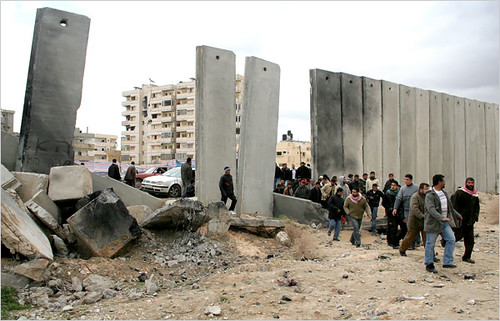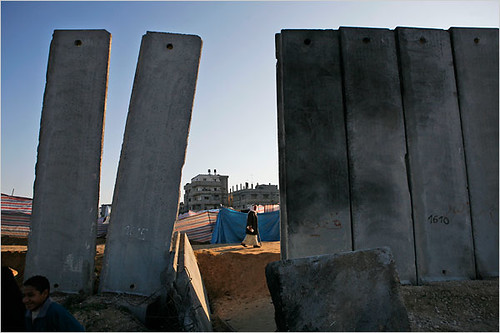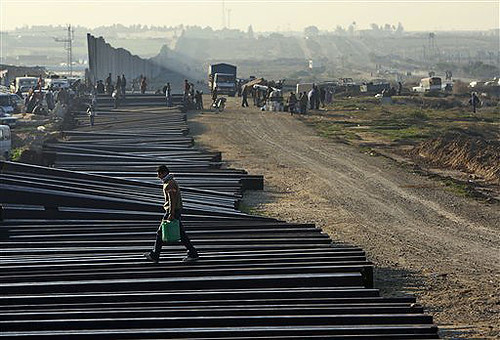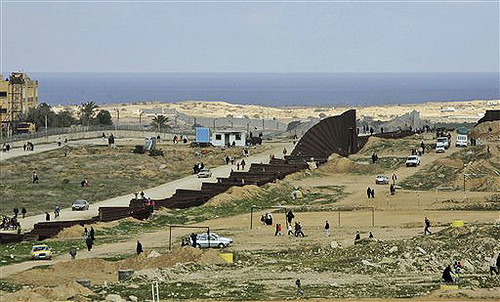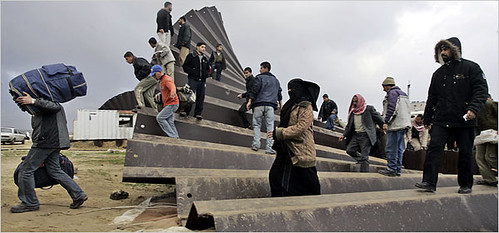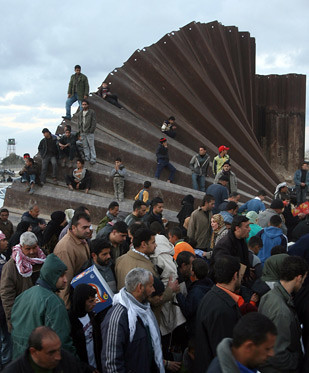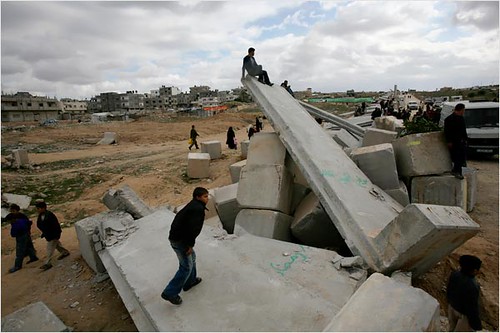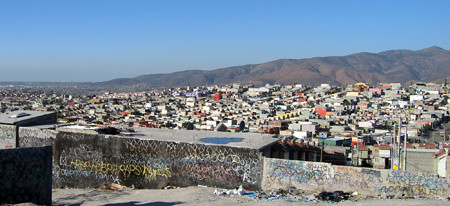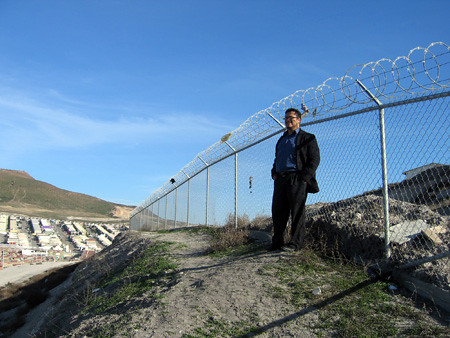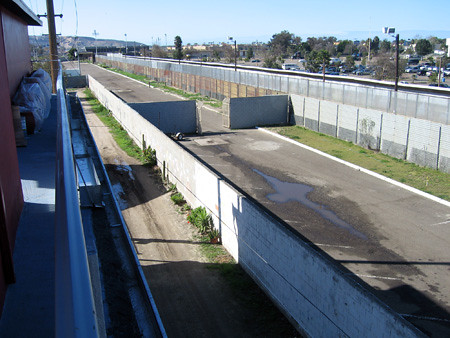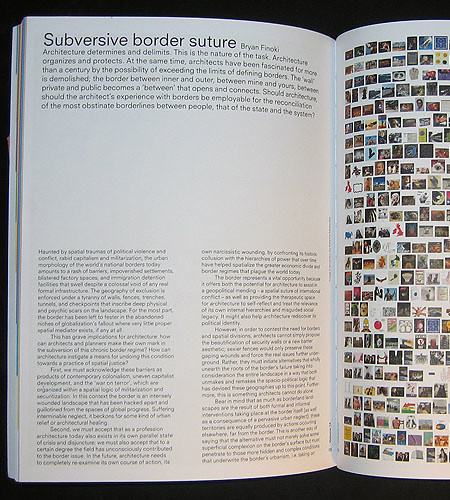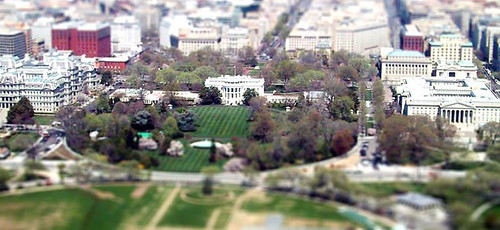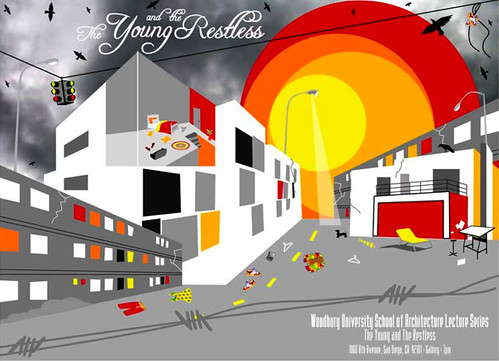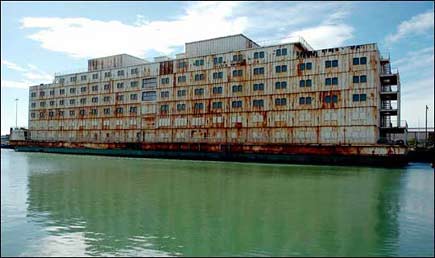 [Image: The Bibby Renaissance, via Is this the first prison ship?]
[Image: The Bibby Renaissance, via Is this the first prison ship?]The deeper I get into it, the more I realize an entire book could probably be written about the subject of floating prisons -– and who knows, maybe in another dream one day I’ll write it –- (there is probably already some magnificent mini opus out there that I have -- for at least the time being -- overlooked) but for now, let’s just settle for a quick and dirty
Googleized survey.
Though it’s been mentioned
here before (albeit pretty minimally, I’m afraid), some recent media coverage makes it’s worth highlighting again with maybe a bit more depth this time –- not to mention the fact I’ve taken a long break from posting and need get my own ship sailing again. And, more importantly, the topic’s relevance to our perpetual little niche of spacio-political inquiry here that, as Squarepusher puts it,
stares sideways into infinity.
 [Image: The Warrior, prison hulk.]
[Image: The Warrior, prison hulk.]There is of course a long lineage of slave ships that date back probably as far as the birth of ancient civilization, but in more recent histories the prison boat (something different, though a seemingly natural progression) really started to evolve during the colonial era; and, not to our surprise, they served as a solution to the overpopulated modern prison systems that were falling apart, (not that different from today’s prison crisis or the similarly bursting detention facilities that hold scores of intercepted migrants, refugees and other global transients.) With that, it is hardly shocking that the construct of a floating prison continues to develop today.
I won’t even try to get into a complete timeline of such a quasi-architectural morphology of the prison ship (not that I wouldn’t love to some day, some how), but in today’s post 9/11 political climate where we are seeing more and more of an interlacing of ambiguously fused, or -– collated -- spaces associated with the issues of terrorism and immigration, I didn’t want to let at least a brief glimpse at the buoyant landscape of ocean bound imprisonment escape our attention.
One place to begin, in addition to the obvious
Wikipedia entries for ‘
prison ship’ or ‘
prison hulk’, is perhaps this article,
The archaeological potential of colonial prison hulks: The Tasmanian case study, by Brad Williams. Without summarizing it, let me say it is (no pun intended) a very interesting and useful docking point to gain background on how prison hulks were built and expanded into a major industry for transporting criminals during the reign of the British Empire through out the 17th and 18th centuries.

To some extent, the colonial history of Australia emerged as a dumping grounds for Britain’s overcrowded criminal society, timed with Britain’s loss of American colonies (a prison system problem lost on none of these three countries still today). So, in essence, an early identity of Australia itself was as a floating prison – a giant contientnal island prison, more like it - making Australia’s use of other nearby islands today as isolated detention centers for Asian refugees barely ironic. The article, however, also gets a bit into the material and spatial qualities of the hulks themselves as they were designed for certain capacities, long term voyages, and ultimately how they would be maintained in proximity to different coastal conditions and land spaces. I found it a good place to start, to be sure.

In another
article, I discovered that Australia around this time used abandoned ships to warehouse criminals in conjunction with the construction of the
Pentridge Prison, a notorious site for Australia’s hardest criminals. More could probably be found digging into this history there.
There are tons of books, as you might imagine (more so than I can name or certainly even know about), but one of particular note is
The Floating Prison: The Extraordinary Account of Nine Years Captivity on the British Prison Hulks During the Napoleonic Wars
written by L. Garneray, which I guess is considered to be
one of the longest and most detailed accounts of life on a prison hulk. Add it to the list.
Another book that looks totally worthwhile as well is
The Slave Ship: A Human History
, or, as Adam Hochschild puts it,
when trade in human beings was lucrative and respectable. A crazy subtitle made even more eerie considering that we are really only referring to a few generations ago, which always blows me away looking back at the dark histories of colonialism -- not that much time has passed! Anyway, a review can be read
here if you are interested.
 [Image: The HMS Prison Ship 'Jersey'. (via Diacritic).]
[Image: The HMS Prison Ship 'Jersey'. (via Diacritic).] For some additional reference on the maritime roots of housing prisoners offshore in England, there are a couple of more sites I came across with some minorly detailed histories both
here and
here, that offer additional historical context on how the Thames, during the Victorian era, was a dangerous place with great concentrations of wealth and therefore attracted a thriving criminal underworld. It was here that eventually
early prison hulks were moored for punishment.
Militarily speaking, there is a more contemporary history to this ongoing narrative of sea-bound detention.
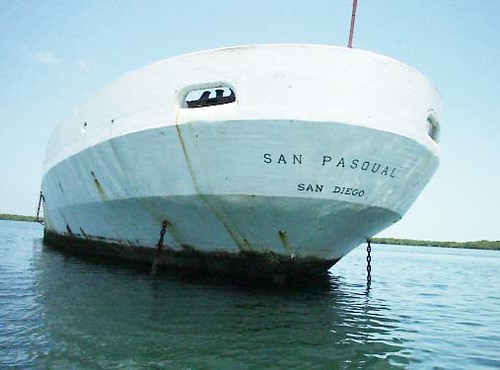
According to this
blogger, with a hefty knowledge it seems of the US’s development of concrete naval ships, (s)he ("Ms. Cornelius") says that “The SS San Pasquale at one time was a floating prison for Che Guevara during the Cuban Revolution and is now a ten-room hotel in Cayo las Brujas”, which seems at least vaguely confirmed by this
article, too.
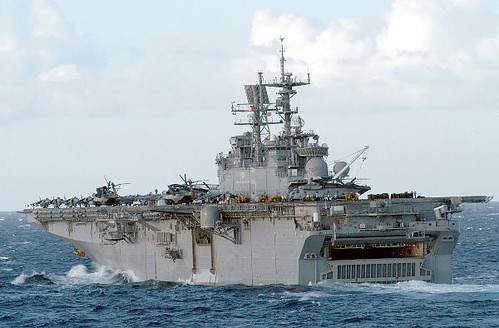 [Image: The USS Bataan.]
[Image: The USS Bataan.]Here we
read that ‘
The USS Bataan was known to have been used as a floating prison, and to have been in the Indian Ocean near Diego Garcia at some point.” According to this
site it was used as a vessel to intercept refugees, but for how long they were held and where they were eventually taken is not clear to me. Still looking into this one for more details.
Human Rights First, however, lists the USS Bataan as a suspected detention facility for War on Terror suspects. Back to the blurring of immigration/terrorist space, interestingly enough, this ship was
on hand post-Katrina to provide a number of civil aid services. A gray area cloud certainly looms over the Bataan's head.
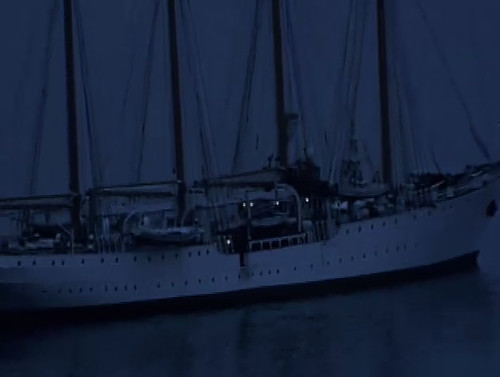 [Image: Chile's Esmeralda, via The Dark Side of the White Lady (official film website).]
[Image: Chile's Esmeralda, via The Dark Side of the White Lady (official film website).] Ashamedly, I still know very little about Chile's notorious vessel, the
Esmeralda, which sailed into Sydney’s Harbor in 2002 bearing with it crude and controversial implications for Australia’s own floating detention island policies. From what I gather, there have been several ships with this name through out the course of the Chilean Navy’s history, but the most recent rendition is still used today, as a kind of “floating embassy” around the world. However, that’s the least interesting point here. Digging through my own ignorance, we
learn that:
“The pride of the Chilean Navy, the Esmeralda, might be a magnificent example of marine architecture, but it has skeletons in its closet. To thousands of Chileans, the ship is a symbol of the country's brutal past.
In the weeks after General Augusto Pinochet's bloody coup in 1973, the Esmeralda was used as a floating prison and torture chamber.”
“Reports from Amnesty International, the US Senate and Chilean Truth and Reconciliation Commission describe the ship as a kind of a floating jail-torture chamber for political prisoners of the Augusto Pinochet's military regime from 1973 to 1980. It is claimed that probably over a hundred persons were kept there at times and subjected to hideous treatment.[1]” - Wikipedia
 [Image: If you can get your hands on it, a documentary film was made about The Dark Side of the White Lady (official film website).]
[Image: If you can get your hands on it, a documentary film was made about The Dark Side of the White Lady (official film website).] There is also the tragedy of the
Cap Arcona, a massive German sea vessel that was used during WWII, transformed into a floating prison to transport inmates from the Neuengamme Concentration Camp near Hamburg between April 26th and 28th 1945. Reading
this, it turns out, that British air forces saw the ship and, unable to resist the target, mercilessly bombed the
Cap Arcona, killing many refugees inside, but surprisingly leaving some survivors.
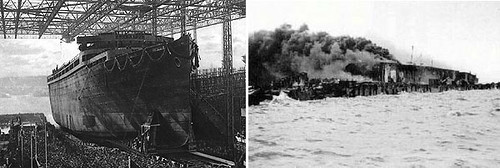
In my future dream book I would love to explore more the political and legal guidelines that were used to secure these vessels for imprisonment purposes given their precise historical contexts, and learn more about the rise in the barge industries that profited off building ships used for prisons. Very curious about whether there was any public opposition at the time, and why/how the hulks were gradually phased out. If anybody has any information on this topic worth sharing, I’d love to hear from you.
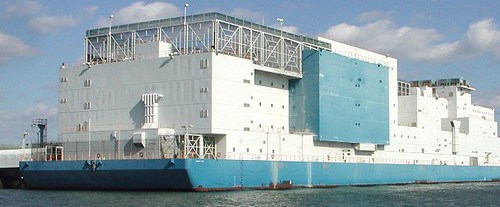 [Image The Bain]
[Image The Bain]To those ends, you may even recall during the early 90’s when New York City, aiming to fix its overcrowded prison problems, built a “five-story jail barge” –-
the Bain -- as big as two football fields, to store 800 prisoners, that was at one point being considered as
something perhaps to be mimicked in Norfolk, Virginia, and
New Jersey, but who would later scrap that plan. At the time, it was considered New York’s most expensive jail at $161m, and
was delivered 2 years late and considerably over budget. The city operated two other barges prior - the Bibby Venture and Bibby Resolution – which were eventually closed in 1992 when “they ran afoul of federal authorities.” The
Vernon C. Bain Center (VCBC), moored nearby Rikers Island (an island jail) is still used today.
 [Image: Terminal Air is a project that explores complex interconnections between government agencies and private contractors involved with the United States Central Intelligence Agency's extraordinary rendition program.]
[Image: Terminal Air is a project that explores complex interconnections between government agencies and private contractors involved with the United States Central Intelligence Agency's extraordinary rendition program.]And, in light of the CIA’s
extraordinary rendition program, which broke in the
media for using unmarked jetliners and secret airport real estate as well as clandestine black sites worldwide to kidnap and whisk terrorist suspects off to be tortured, there were, via
Diacritic,
reports that these suspects were being kept on military ships as well. Though I haven’t found much more about that.
So, even though prison hulks became somewhat obsolete in the mid-19th century, floating prisons never really seemed to die, in fact they may even be making a quiet comeback in various corners of the world again right now.
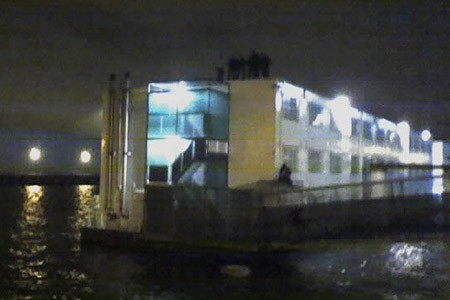
The Netherlands -- unable to lease bankrupt islands in the Pacific, and lacking needed real estate –- have somewhat mimicked the Australian system of offshore warehousing for intercepted refugees and migrants by stocking a new wave of hulks moored off its own docks in the industrial zone of Zaandam, just north of Amsterdam (via
No Border Network).
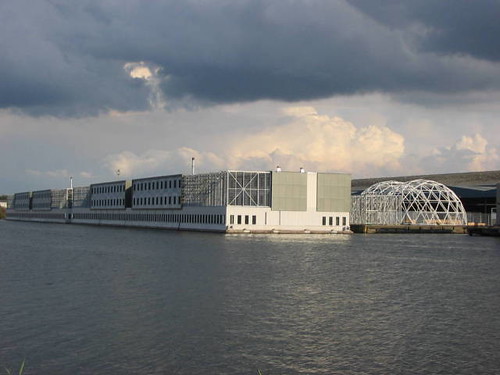
A BBC
article a few weeks ago took a peak inside them, when at full capacity are capable of holding as many as 576 captured migrants each. Boasting an urban flexibility, officials say, in some ways they are more ideal than traditionally built ground-based prisons or detention facilities because they are now –- if need be –- fully mobile and fully transportable. That doesn’t exactly set my stirred stomach much at ease, I have to say.
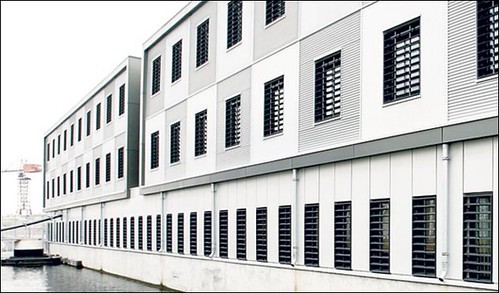 [Image: Via At Last It's Time to Cell-ebrate.]
[Image: Via At Last It's Time to Cell-ebrate.]Structurally, the prison, we are told, “sits on two concrete platforms, each in turn moored to large steel pilings.” Adjoining them to dry land are “two white domes” specially designed by a Dutch artist (surprisingly enough) “made of a lattice-work of metal” where “the inmates play sports like football or basketball.” The prison boats are entered through small bridges and inside are “corridors of cells” and “communal areas with table football, table-tennis and payphones.” The BBC say the cells each hold two people “with bunk beds, a desk, fridge, TV, even a coffee machine”, while a shared bathroom provides a toilet and shower. Another
article says, “While detainees await their expulsion they are subjected to a fairly mild prison regime with the cell doors opened during the day. There is television in every cell and a communal fitness room, a recreation room, a library, a room for religious services, a film room and an arts and crafts room.”

The migrants are locked here for 15 hours each day, and apparently can remain there “for six months or longer, as the authorities try to identify them and persuade them to go home voluntarily.” After nine months, “If the authorities cannot identify someone properly, Dutch law says that after nine months in detention they have to be released back onto the streets.”
If I must acknowledge something positive about these facilities they do sound much more humane than plenty of other immigration holding camps I can name. And the guiding philosophy of keeping the detainees active and not rotting idly inside their cells speaks mini-volumes to the more progressive approaches that can be taken to dealing with the refugee crisis, despite the fact I don’t support refugee incarceration of any kind, really. And the strategy to keep them separated from the criminal population in the nation’s formal prisons is the very least they could do, though it is more so probably motivated by the fact that prison space is simply too lacking to house additionally large numbers of asylum seekers. There are also groups like the
International Organization for Migration (IOM) working closely with the migrants, if only to persuade them to return back to their home country, it seems, but who at least appear to have some kind of oversight of their treatment, which again cannot be said of many other places.
Sliding down the human dignity scale of floating prisons, however, I recall back in October of 2006, when Britain
announced plans to open a new “super-prison ship” to hold hundreds of overflow inmates that would be moored on the country’s coast as well. The Home Office admitted in the
London Times that the immigration crisis was so severe, a new floating vessel was being sought to hold between 200 and 800 prisoners -- “either low-level offenders or illegal immigrants facing deportation,” one government spokesman said. The fact that captured migrants and petty criminals would share the same detention space just points out further how the issue of immigration is being dealt with primarily as one of criminality, and as a security threat issue rather than a humanitarian one. It is deplorable, frankly.
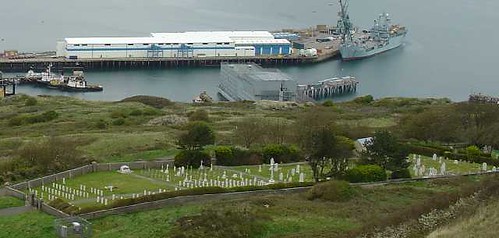
Ten years ago, Britain bought a prison ship from the US to cope with overcrowded cells.
HMP Weare is a prison ship berthed in Portland Harbor in Dorset, England. HMP stands for "Her Majesty's Prison". The UK established it in 1997 “as a temporary measure to ease prison overcrowding. Weare was docked at the disused Royal Navy dockyard at the Isle of Portland. On 9 March 2005 it was
announced that Weare was to close, mainly due to the costly running and it being unnecessary. But now the Government is said to be in the market for another floating jail.
 [Image: Bibby Renaissance (via).]
[Image: Bibby Renaissance (via).]Whether England still plans to build a new prison ship or convert an old barge remains to be seen, I guess. But, according to this article, there were talks both back in the 90’s and even more recently of the British government using an old barge --
the Bibby Renaissance -- as a floating jail, but
apparently that was decided against. Instead, the six-storey high barge is now on a “75-day, 10,000-mile journey to China where its empty shell interior will be fitted out as a hotel.” Interesting enough, “the Bibby Renaissance belongs to Bibby Marine of Liverpool which owns
several other so called “floatel” barges,” including the two that are being used by the Dutch government.
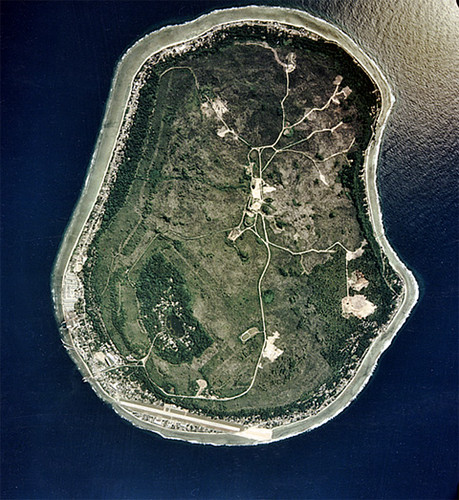 [Image: Nauru Island, South Asia. An Australian Refugee detention island.]
[Image: Nauru Island, South Asia. An Australian Refugee detention island.]Thinking of these floating camps in the greater context of detention archipelagos -– a la Australia’s offshore detention islands -- we can’t help but be reminded of the refugees from New Orleans who, after hurricane Katrina, were temporarily relocated to a few vacant cruise ships docked in the Mississippi River, and then were moved again due to contract issues and the fact that the harsh season was keeping them in grave danger there. More importantly, not to mention the obvious fact that the boat space itself was literally and politically dislocated from everything essential to making it possible for these refugees to rebuild their lives again. These refuge boats, like Australia’s detention islands, altogether indicate how different spaces of exception manifest, not only as politically dislocated sites but as literal physically detached products from the shores of political inclusion as well. You may or may not recall but there was even debate about whether to call them refugees or not, that would somehow decide the legal and political responsibilities and treatment of the hurricane victims based on that determination. While they were no doubt refugees within their homeland, what might that mean for their status at that point? Their classification may have not been as easy as it seemed.
When I then
read that Honolulu is floating around the idea of converting a vacant cruise ship into some kind of Rehab Center that would house homeless and formerly incarcerated persons, my enthusiasm for any sort of cleverness associated with this plan is overshadowed by a deeper suspicion of the perpetual logics of exclusion such spaces of “rehabilitation” are constantly embedded within that, in the end, only further banishes and quarantines people to the fringes of biopolitical bankruptcy where their lives are ushered from one space of exclusion to another.
While the dislocated spaces of the prison cell and the rehabilitative cruise ship cabin may seem miles apart, shouldn’t we be more concerned about the spatial political connections that may underlie them? Now, I admit, I know very little about any of these real examples, or about the political guidelines that have established their viability. But from a purely spatial point of view (forgive this perspective as a flimsy spatial fetish) perhaps these spaces are merely different kinds of architectural isotopes meant to permanently suspend the biopolitically inferior ‘floating populations’ of the homeless, or the refugee, the migrant, or the released prison inmate, altogether holding them captives along the same shores of limited access to a properly politically-grounded space of inclusion. Instead, they become endless spatial by-products of the architectures of perpetual displacement.
At the very least, it is certainly the last place you’d ever want to be in the event of a tsunami, which only makes me more deeply skeptical about how certain subgroups of people are, in a sense, left out on the slab and hidden from any sort of integrative visibility within the more legally and physically protected mainlands of society.
This also reminds me of hearing a year or so ago about these offshore floating sweat shops that were popping up far off of California’s coastlines where Mexican and Indian migrants alike were said to be assembling cheap consumer products, or programming software packages outside the bounds of enforceable fair labor practice, bobbing up and down on the run-on waves of globalization’s boundless economy. I don’t have much more on that, and can’t say how reliable that story is, but one can only imagine a future where chains of old cruise ships, and abandoned military vessels, and random sea born architectures create topological barrier reefs outside capitalist nations with fleets of floating maquilladoras and loosely linked networks of anchored factory barges, while smaller piratical trade boats peddle cheap wares to and from the coast.
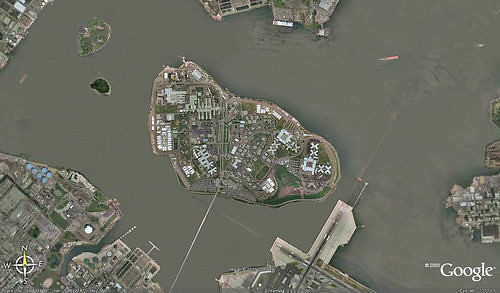 [Image: Riker's Island, New York. An American prison.]
[Image: Riker's Island, New York. An American prison.]I’d love to hear Keller Easterling’s thoughts on this subject. In her book
Enduring Innocence: Global Architecture and Its Political Masquerades
, she nicely dissolves the philosophic and metaphoric temptation of referring to the sea as a political landscape of multiple logics, where both the neoliberal and hyper-Marxist rationales are lured by the frictionless, borderless, de-territorializing and amorphous liquid space of the ocean, that can be used to either boast the fluidity of an egalitarian and globalized world economy, or the subversive wet plains of piracy and counter-empire spaces that resist any singular overarching political constitution. Either way, she has a great chapter about the oceanic relevance of the nature of politicized space, the logistic and anti-logistic productions of territoriality, and a couple of passages seem too relevant not to include here.
“Worlds and empires shelter and fatten offshore, dropping into protected enclaves, free economic zones, and paper sovereignties long enough to avoid taxes, engage inexpensive labor, or launder an identity. Streamlined logistics and loosened legalities are among the bullet-pointed features of every logistics park and free economic zone in the world. Their segregation from other worlds and other nations helps them to garner power, and shapes them into distended and dominating territories that are constantly expanding and excluding. They are the world with their own seas.”
“In Jacques Ranciere’s speculations, the sea is a medium of insurgency and democracy. Ranciere’s sea is not a frictionless sea but, rather, a rough space of contention: “It smells of sailors.” The sea is capable of enriching and disrupting the landed politics of consensus. Once on a shore, political organs dilute the sea’s raw democracy, as if secretly wishing for the end of politics or a delivery from the sea’s unknowns. Land and sea again appear to be a pair, or two halves of a single world. Yet the site of this contemplation is the shore, the interface between raw democracy and political organization. Wherever that interface exists, there is a platform for which to counter what Carl Schmitt called the “shoreless sea” of legal exception. In Ranciere’s characterization, this slipstream is not a space of least resistance but, rather, a space of traction and contention.”
“like shores, these areas of intolerance between worlds sustain and are sustained by error piracy, or the contentions of democracy. As interfaces between worlds, they form a perpetual wilderness with limitless surface area – always newly minted, and often underexplored. However rough they may be, these seas are also spacious, mixing different waters and different political constitutions.”
And so, what shores have we moored these futuristic immigration prisons on? What dark and contentious legal waters have we cast the management of untried terrorist suspects and unsorted global refugees to, either inside the bowels of some classified naval destroyer, or perhaps packed inside the cargo spaces of the greatest floating prisons of all time – the CIA’s unmarked 747? If the archipelagic networks of detention islands are no longer outside but now included within the sovereignated seas of Empire's subtle creeping expanse, then what political constitutions have been traded for the nomad who now finds himself locked inside a prison cell with miles of oceanic gap separating him from both his homeland of old and new?
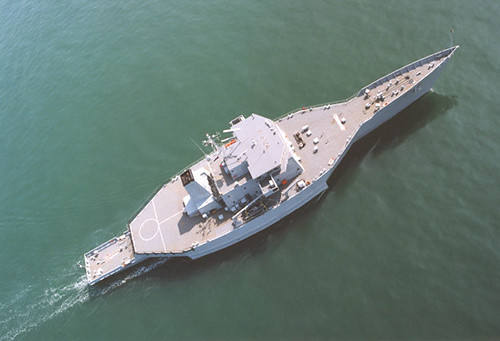
While we are at it, don’t forget about Australia’s other more nimble maritime floating prison, the
Triton (previously mentioned
here), a 98-meter trimaran capable of detaining and storing up to 30 people for a month once captured crossing into Australian sea territory. It’s not a floating warehouse but rather a military cruiser armed with machine guns.
In fact, the BBC even
reported a proposal last year between the U.S. and Australian governments to conduct swaps of up to 200 asylum seekers each year, as a kind of deterrent for migrants looking to try their luck sneaking into the U.S. The idea would be to set an example, that to try and enter American territory without permission could potentially land you on a
remote refugee camp somewhere in the Indian Ocean instead, or, perhaps the
new migration holding facilities they are building on Guantanamo Bay. But, analysts have been quick to point out that Australia could face new boat loads of Asian refugees hoping to luckily get swapped to a vantage closer to America’s shores, thus producing the opposite of the intended effect. Instead, what if it generated a kind of informal human smuggler’s lottery?
 [Image: Alcatraz Prison, San Francisco, California.]
[Image: Alcatraz Prison, San Francisco, California.]Anyway, while devising refugee spaces on water may seem in some scenarios like an inventive architectural solution to a critical lack of land space, their physical detachment from any landscape reflects a much more alarming concern that the crisis of global migration isn’t being met by new and inventive spaces of humanitarianism, but rather it is only being compartmentalized, peripheralized –-
incarceralized -- perpetually suspended and disenfranchised amidst the more hidden and distancing folds of a barely observable political shorebreak.
Either way, the whole notion conjures a sense that refugees and migrants are just an excess of biomass to be herded around on prison islands or in prison vessels, traded like geo-economic commodities, removed and disposed of like capitalist human waste, reinforcing the state of exception that goes on re-organizing the architectural spheres of global migration.
Will there come a day when the world’s oceans are dotted with new hegemonic naval networks of prison floatillas patrolling the human smuggler routes of lost seas, scooping up thousands of refugees like schools of fish in a great surveillance net –- are these seafaring detention schooners the foretold aquatic walls of a
nomadic fortress? Retroactively honoring the nautical roots of globalization, this new industrialized human cargo business would circulate these detention ocean liners through an endless maze of militarized channels, winding in and out of the 21st century’s great detention archipelago, where they may or may not be lucky enough ever to set foot on soiled land again.
God forbid Hollywood should offer any premonition, but (and perhaps this is a grossly a ridiculously sensationalistic way to end this post), you may remember John Woo’s movie
Face/Off where one of the main characters gets shipped off to Erewhon prison, a converted derelict oil platform at sea. Based on
a novel by the same name written by
Samuel Butler, the film is much different, but depicts a secret futuristic remote prison where inmates wear heavy steel bound boots that magnetically bolt them to the floor, and wall projections of little fauns feeding in dewy forests provide spooky therapeutic effect over the chaotic dinning hall. With guards eager to abuse the inmates with their electric taser wands perhaps the most telling moment in the film is when the Warden addresses him upon entry, and
says: “You are now the property of Erewhon Prison. A citizen of nowhere. The Geneva Convention is void here; Amnesty International doesn't know we exist. When I say your ass belongs to me, I mean exactly that.”



